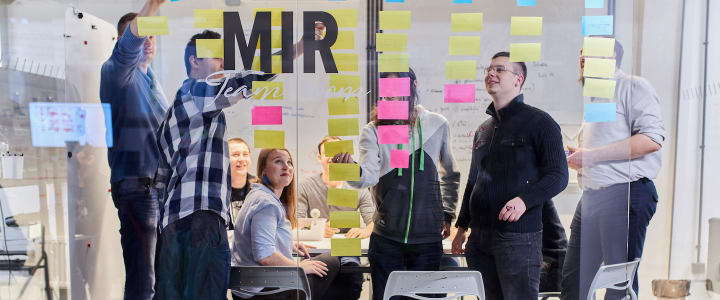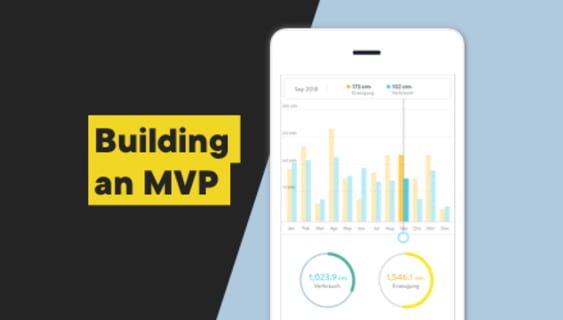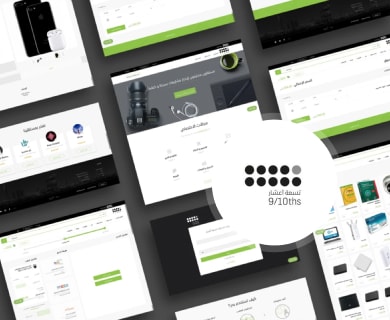Get huge by starting small - 5 successful digital businesses which started with MVP
Delivering brand new digital products to the market is always a risky business. To make sure that your efforts and money don’t fizzle out, you might consider developing an MVP first. But is it worth it?

Table of contents
“Rome wasn’t built in a day”, they say. But if Romulus had only a few months to make it happen, what would he have done? Unfortunately, in 753 BC the founders of the eternal city didn’t have the chance to call an agile dev team to build an MVP.
An MVP (Minimum Viable Product) is best described as a minimal manifestation of your idea which is ready to be validated by the market as soon as possible. Thanks to the lean approach, you’re saving time and can release a product before your potential competitors. It can also be a cost-effective solution at the early stage of the project.
In the Rome example, Romulus needs to make sure that people really want to live in the place he’s creating. That’s why the future capital city should remain open from the very beginning (transforming from a village to town and then to the metropolis) to gather constant feedback from citizens and improve on it. The beauty of the MVP approach is that it works for any industry.
The following MVP success stories show that even the most ambitious projects started as simple (but still effective) apps with only core functionalities.
Dropbox: skyrocketed by two videos
In 2007, the famous cloud storage and synchronization tool was still far from ready to be launched as a commercial product. Despite having a working prototype for Windows, Dropbox founder, Drew Houston didn’t want to reveal a single line of code.
Instead, he published a short explainer video on the Hacker News website. The three-minute screencast showed the basic concept of the app: instant data synchronization between two PC devices, revision control and sharing files with public folders. Houston emphasized Dropbox’s incremental data sync feature: only modified bits of information were transferred.
The video targeted the community of technology early adopters and succeeded in getting their attention. One of them was Hacker News creator, Paul Graham, who also ran Y Combinator, a startup incubator. That’s how Dropbox got its first seed funding. The time to iterate had come.
A year later, Houston released another demo video on Digg - a Mac version with much more polished design and functionality. Dropbox now offered the option to restore deleted files, with access to all previous revisions, sharing folders and a photo gallery. The project gained even more publicity, this time including tech news outlets, leading to a rapidly-growing user waiting list.
The beta sign-up list went from 5,000 to 75,000 overnight.
At the Startup Lesson Learned 2010 conference, Drew Houston summarized his experience in a single sentence that describes the core components of the lean startup feedback loop. It is critical to put something in the user’s hands (the build phase) and get real feedback as soon as possible (the measure phase). But first, we have to verify our assumptions about customer needs (the learn phase). In the Dropbox example, the two explainer videos were the minimum viable product.
Dropbox now has over 500 million registered users across 180 countries. The current company valuation exceeds $9 billion.
Product Hunt: turning an email experiment into an MVP
Product Hunt is a website that lets users share, discover and discuss new and interesting products. Thanks to comments and a voting system, it’s up to the community to choose the best of them on a daily basis. But when the project’s founder, Ryan Hoover came up with the idea in 2013, he realized a vast amount of work was needed to build the first version.
Hoover wasn’t sure if anyone else would want to use a service like this. He needed a simple and reliable way to test his hypothesis and he needed it quick. In a mere 20 minutes, Hoover built an email list using Linkydink, a link-sharing tool. Then he invited his closest friends from the startup community to take part in it.
Within two weeks, the email experiment had grown to over 170 subscribers, with overwhelmingly positive feedback, despite a lack of marketing. Once again, an MVP proved to be the key to success, giving Hoover the confidence to develop his idea further. He could deliver a prototype quickly but also confirm and clear the innovators’ assumptions.
Iterating on the MVP results, the first version of Product Hunt was launched eight days later during the Thanksgiving break. In 2016, the service was bought by AngelList for $20 million. Today it acts as a central hub to discover promising projects from startups and independent creators in the tech industry.
Groupon: a sub-domain to a failed venture
Andrew Mason spent 11 months developing and polishing The Point, a website dedicated to accomplishing social goals. And then The Point misfired completely. Mason learned a valuable lesson. It is necessary to deliver just enough functionality and value to appeal to early adopters.
An MVP seems the only way to mitigate the risk of spending time and money launching a product that nobody wants to buy. Mason’s new idea turned out to be Groupon and was ready in a month. It started as a WordPress blog in The Point’s sub-domain. Coupon Deals for the local pizza shop in Chicago were served daily as standard blog posts.
Before developing any software, Groupon customer orders were handled manually by email. By choosing the Wizard Of Oz type of MVP (human workforce emulating automated systems) he could start without a complicated back-end infrastructure, still learning about customer needs, and with minimal effort. It gave Mason’s project powerful foundations to iterate.
A similar approach to Wizard of Oz is the Concierge MVP. The main difference lies with the user experience. In the second one, the customer knows that he is dealing with a human. Most times, human interaction creates more value for the product. It also helps with defining the solution hypothesis.
After the first six months, Groupon expanded to Boston. The company valuation crossed $1 billion after just 16 months in business. Within two years a simple, yet validated idea, had turned into a successful business with monthly sales surpassing $100 million. Groupon has become an object of interest to big tech companies like Yahoo! and Google.
Uber: Less is more. Focusing on a small market
Turning an idea into a palpable product often goes hand in hand with the desire to add as many bells and whistles as possible. Businesses tend to instinctively cater to the broadest market needs. But this mindset blurs the definition of core value. Taking the lean path focuses on simplifying the user experience instead.
Back in 2010, ride-sharing app Uber (formerly known as UberCab) was used only by its founders (Travis Kalanick, Garrett Camp) and their friends. To get access to UberCab you had to email Kalanick or Camp directly. The service was initially tested in New York using three black limousines. A few months later UberCab beta landed in San Francisco.
What did they have in the beginning? A simple mobile app for iPhone users that you could use to book and pay via SMS. Uber was far from ready but after a few iterations the project gained traction. That’s how on-demand cab services with in-app payments available at the tap of the button formally clicked.
Initially UberCab and then Uber targeted the big-city commuter who wants a luxury ride. Gradually they expanded the basic MVP app, but only after receiving feedback from users. New features were based on previously validated premises. The company had accurately X-rayed the market.
Apple: Don’t validate the product. Just confirm the need
Yes, Apple’s first iPhone changed the world. But compared to today’s standards, a first-generation iPhone from 2007 is a brick. A limited number of apps (App Store launched a year later), no ability to copy & paste text (it took three years to add this feature), no notification center, unchangeable black background, etc.
It was a conscious decision. The company focused on evaluating the core concept which fits into the Minimum Viable Product strategy. It should be underlined that the iPhone could be, in fact, treated as an iterated version of the iPod. Yet this single device for calling, messaging and listening to music started a long conversation with users.
A similar conclusion can be drawn from the company’s software development. The early versions of iOS lacked a lot of features that alternative mobile platforms already had. Initially, Steve Jobs didn’t plan to let third-party developers build apps for iOS. However, developer backlash and jailbreaks persuaded the Apple founder to change his mind and release a software development kit.
Of course, a solid MVP shouldn’t cut corners. You don’t want your users to struggle with bugs. The first experience with a vital feature is crucial to get valuable feedback that can be mapped as future functions. Besides money, a lean strategy saves the time needed to test your idea on the market.
Check out MVPs built by Boldare’s development teams
Successful MVP cases - summary
As wannabe innovators, we have a tendency to dive in, confident that our product vision and purpose are valid. We tend to be convinced about the value our idea would bring to the market and customers. In the end, we are left alone with empty pockets and our new-born child, whom nobody wants. Our ego doesn’t want to accept the fact that we failed.
Omitting the early stage of the business product development cycle leads to greater risk at a later stage. The above examples prove that the MVP has a crucial role in the process (it comes to mind as an analogy for solid structural foundations that you can build on). There are a few good practices that make your MVP potentially successful:
- only vital ingredients (focus on one core feature)
- make sure that your MVP is viable for use (actually works without crashing)
- try to act fast (no time to polish)
- you don’t have to spend much money but you should do so wisely
- collect data and feedback from the users
- set up actionable metrics to measure the data that matters and watch out for vanity metrics
- have a roadmap of constant iterations
An MVP is not a bulletproof vest which will shield you from mistakes and setbacks. But it is the ultimate tool to check if your business idea is worth pursuing. It will minimize your costs, delivery time and effort, and give you the most precious asset these days: data about your users. With what an MVP gives you, you can improve your product, make it more compelling and reduce the risk of failure. Yes, it’s worth it!
Share this article:











